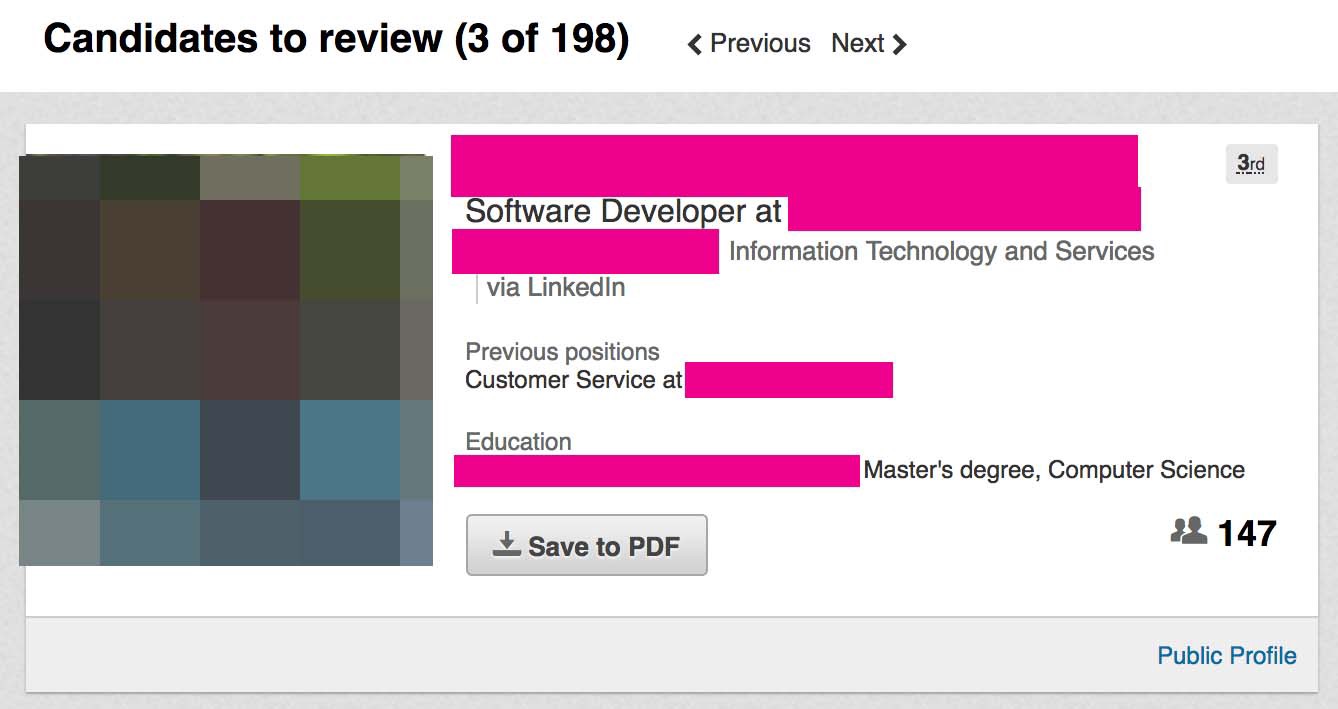
Now that I have started a new job, I?ve gone from job-applicant to applicant-reviewer. Here is what you need to know before you ?Easy Apply? on LinkedIn: ?Easy Apply? might as well be ?Easy Rejection.?
Sure, it is easy to apply for lots of jobs quickly (and LinkedIn wants applications so they can brag to employers about how they generate lots of leads). But, you must develop your content, plan an approach, and take your time to put your best self forward.
Your application is one of HUNDREDS
LinkedIn?s ?Easy Apply? tool means your job application is in a pile of hundreds of other job applications. Many applicants do not spend more than thirty seconds considering the role before clicking ?Easy Apply.? I am amazed at how many people have no applicable experience or skills. It?s as if they didn?t even bother to read the job description.
Be discerning about your applications on LinkedIn. If the role you?re applying for is different than your current skills & experience (even a little), you must craft your profile to show how you can succeed in the new role. Use the summary section to talk about how you are ready for more responsibilities, or have been doing this work in a freelance or volunteer capacity already, or have taken educational or certification courses to bring your skills up to the job requirements.
Employers only see a short summary of you at first
 Employer view of candidate in listings (name & photo redacted)
Employer view of candidate in listings (name & photo redacted)
Before employers see your resume or your complete profile, they have to select you from a long list of candidates. The candidate list an employer sees ONLY includes the following information: your picture, name, location, and headline. That?s ALL employers have to decide whether you?re a good candidate or not.
Use a professional-looking headshot, not your vacation photos, even if you look good. If you do not have a picture, then you are probably not getting a response.
Your headline should be the job title you want fit into 30 characters, even if it isn?t your current job title. Why? THE HEADLINE IS TRUNCATED TO 30 CHARACTERS. If all employers see is your headline truncated to ?Currently seeking a position in?? you?re getting skipped. Do not write that you are currently a student or unemployed; that is a waste of space. Good headlines are short, succinct, and aspirational: ?Front-End Developer with 3 yrs??, ?10 yrs in Payroll Accounting??, ?Software Engineer with MS in CS??
Your LinkedIn profile IS your resume
 LinkedIn job candidate profile heading (personal information and photo redacted). The profile summary, work experience, education, etc. (not shown above) is below this header box .
LinkedIn job candidate profile heading (personal information and photo redacted). The profile summary, work experience, education, etc. (not shown above) is below this header box .
Even if you submit a resume in your application, ?Easy Apply? shows employers your LinkedIn profile first and buries your resume behind a tiny link. Employers reviewing your application will look at your profile to vet you for a role, and then look at your resume as a backup.
Your profile has to be at least as complete as your resume and frankly, should have more information than your resume. Do you do charity work? Active in your community/school/church? Those do not belong in your resume, but it really helps differentiate you on LinkedIn.
Also, get LinkedIn recommendations by writing recommendations for friends, then ask them to write one for you. Be active on LinkedIn by posting, commenting, or even just ?liking? the stories others post. Lastly, use the ?summary? part of your profile to write a message to employers ? think of it as a cover letter.
And yes, you should always include a resume in your application, even though LinkedIn says it is optional. Anything that helps give employers a more complete view of you helps.
You will be ?filtered?
 Candidate filtering options hiring mangers use to filter you.
Candidate filtering options hiring mangers use to filter you.
There?s no way around it. Employers will use filters to sort through the hundreds of candidates. The main filters we use are keywords, job title, location, and geographic area. Is your application going to make it through the filter?
Your profile text MUST include keywords that match the job description. Use variations of filter keywords in your profile summary and job descriptions (include both ?developer? and ?engineer?, for example). Include technologies you have used in your list of skills.
Make sure your previous job titles match the job you want, or at least have some relation to the job you?re applying for. If you are trying to break into a new industry, then say you?re a freelancer in that industry now.
Employers will also filter by location and geographic area. Location is the specific metro area, while geographic area filters out candidates applying from overseas. If you want to relocate, then change your current location to match where you want to be.
Curate your portfolio or website
If you include a portfolio or personal website, employers will visit it, so make sure it works and there are no broken links. It is an instant rejection when you didn?t bother to get your own website to work. Also, curate your Twitter and Instagram presence, or make them private, cause we will look at them before we contact you.
Consider how to combat unconscious bias
LinkedIn does not allow filtering by age, race, or gender. But even the most progressive hiring managers still have unconscious biases. It is not fair (or even legal), but if you are from a ?diverse? background the previous advice applies doubly to you.
Write your profile to be assertive about your knowledge and experience ? leader, go-getter, fast-learner, expert, etc. Make your profile picture the most professional you can ? clear and well lit, business attire, office setting. Be clear about your work authorization status. And use your background to your advantage by highlighting your diversity as a reason to consider you. No, you shouldn?t have to do these things, but you want every advantage you can get.
Reply back!
Finally, if you do get contacted by an employer, REPLY. So many great candidates can?t be bothered to respond. Extend some professional courtesy and respond to messages and calls, even if it is a job you do not want anymore. Even better, respond with a referral of someone else we should contact. We?ll remember you when new jobs open.
That?s it! If you follow these steps, you will greatly increase your chances of getting a response from an ?Easy Apply? job application.


